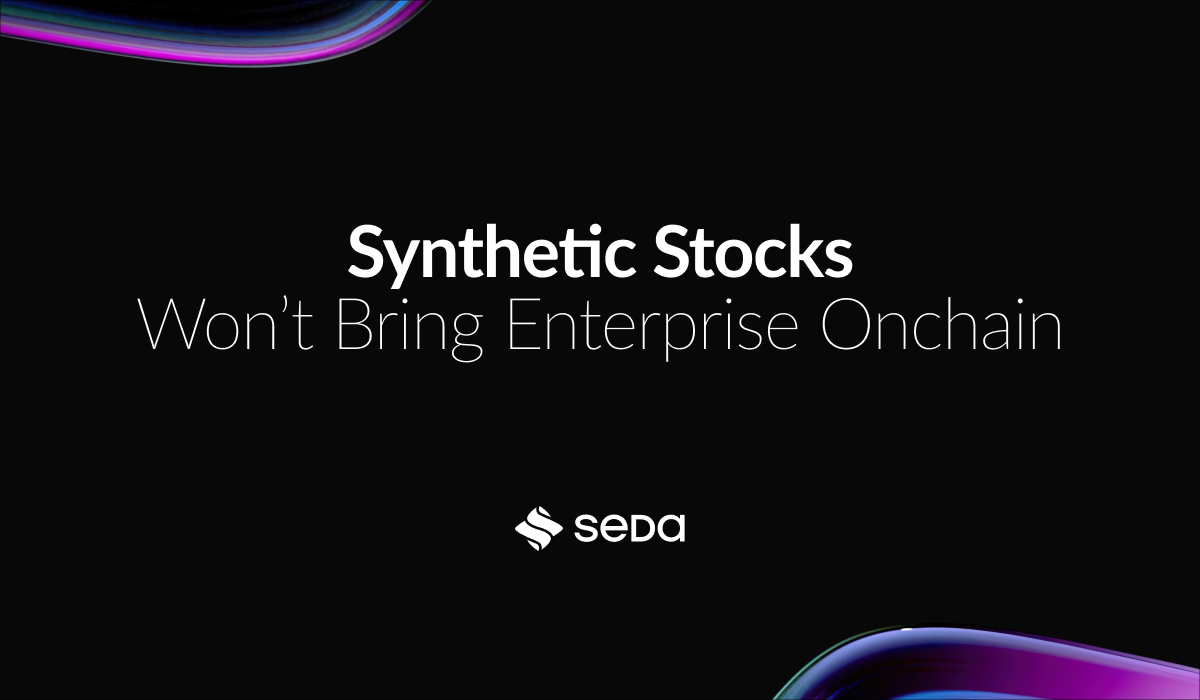Synthetic Assets Won’t Bring Enterprise Onchain.
Education & Community

As blockchain infrastructure matures and traditional financial institutions explore the onchain world, one thing is becoming increasingly clear: tokenized assets, not synthetic assets, are the gateway to onboarding institutional capital and enterprise-grade liquidity.
Both asset types have their place in onchain finance, but when it comes to legitimacy, legal clarity, and alignment with existing financial structures, tokenized assets are more suitable for traditional finance.
The Difference Between Tokenized Assets & Synthetic Assets
Tokenized Assets
These are digital representations of real-world assets, such as stocks, bonds, or real estate, issued on a blockchain. Each token is backed 1:1 by the underlying asset, held in custody by a regulated entity. Token holders often have legal and economic rights to the asset, including dividends, redemptions, or governance. A key difference is that tokenized assets reflect the entirety of the real-world asset onchain such as corporate actions.
Synthetic Assets
These are derivatives that track the price of real-world assets using collateralized smart contracts and price oracles. There is no real ownership. Only exposure to price movements. They’re fully onchain but not legally linked to the real asset. Examples include sAPPL (synthetic APPL) that can be traded across weekends unrelated to the price movement of the real-world APPL stock.

5 Reasons Traditional Finance Prefers Tokenized Assets
1. Legal Ownership & Compliance
- Institutions require clarity. Tokenized assets can be issued under existing legal frameworks with real shareholder rights, tax treatment, and disclosure.
- Synthetic assets offer no direct ownership and are unlikely to pass regulatory scrutiny for enterprise use.
Take-Away: Custodied, regulated tokenized assets may integrate into existing legal and financial systems. Synthetics typically do not.
2. Institutional Acceptance
- Tokenized assets can plug into compliant custody solutions, fund structures, and investment mandates.
- Synthetic assets are more aligned with speculative DeFi activity and typically lack auditability or reconciliation with traditional systems.
Take-Away: Asset managers can hold tokenized stocks in portfolios. They generally can’t hold a crypto derivative pretending to be a stock.
3. Dividends, Voting & Corporate Actions
- Tokenized assets can be structured to pass through dividends, execute corporate actions, and respect governance rights.
- Synthetic assets have no connection to the underlying issuer — they don’t inherit these features.
Take-Away: Enterprises want utility, not just exposure.
4. Reduced Risk Profiles
- Tokenized assets are usually 1:1 backed, meaning price reflects underlying fundamentals.
- Synthetic assets are vulnerable to:
- Undercollateralization
- Protocol failures
Take-Away: Institutional capital seeks risk-adjusted returns, not protocol exposure.
5. Regulatory Alignment
- Governments and regulators are actively exploring tokenized RWAs.
- Most regulators view synthetic assets as unregistered derivatives, making them challenging for institutional use.
Take-Away: Tokenized assets fit into existing frameworks. Synthetic assets challenge them.
Will Synthetics Disappear From Onchain Trading? — No.
Synthetic assets are useful for:
- 24/7 speculation
- DeFi-native composability
- Price exposure without custody
But they’re not a bridge to institutional adoption, they’re a tool for DeFi traders. The goal of onboarding billions of dollars in TradFi capital into the onchain ecosystem requires infrastructure that feels familiar, safe, and regulated. That’s what tokenized assets provide.
If DeFi wants to scale beyond crypto-native users, tokenized assets are the way forward. They align with how traditional finance thinks, operates, and regulates. They are the next step in onboarding enterprise to the onchain financial system.

.svg)


.png)
.png)
.png)
.png)
.png)


